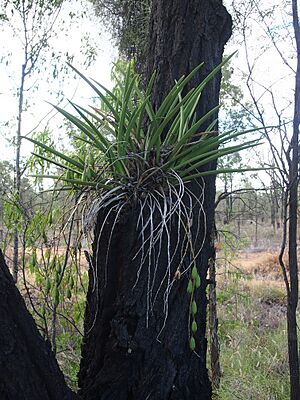Channelled boat-lip orchid facts for kids
Quick facts for kids Channelled boat-lip orchid |
|
|---|---|
 |
|
| Cymbidium canaliculatum flowers | |
| Scientific classification | |
| Genus: |
Cymbidium
|
| Species: |
canaliculatum
|
| Synonyms | |
|
Synonyms
Cymbidium sparkesii Rendle, J. Bot. 36: 221 (1898).
Cymbidium canaliculatum var. sparkesii (Rendle) F.M.Bailey Cymbidium canaliculatum f. aureolum Rupp Cymbidium canaliculatum f. fuscum Rupp Cymbidium canaliculatum var. marginatum Rupp Cymbidium canaliculatum f. purpurascens Rupp Cymbidium canaliculatum var. barrettii Nicholls Cymbidium canaliculatum f. barrettii (Nicholls) O.Gruss & M.Wolff Cymbidium canaliculatum f. sparkesii (Rendle) O.Gruss & M.Wolff Cymbidium canaliculatum f. viridiflorum D.P.Banks |
|
The Cymbidium canaliculatum, also known as the channelled boat-lip orchid or tiger orchid, is a special plant. It belongs to the orchid family and is found only in Australia. This orchid grows in clumps on other plants, like trees. It has thick, grey-green stems called pseudobulbs. From these stems grow long, curved leaves.
This orchid produces many beautiful, sweet-smelling flowers. These flowers can have different colors, often with spots or blotches. They also have a unique white or cream-colored "lip" petal with red marks. You can usually find this orchid growing in the forks or hollow parts of trees. It lives in areas from New South Wales all the way to northern Western Australia.
Contents
What Does the Channelled Boat-Lip Orchid Look Like?
The Cymbidium canaliculatum is a plant that grows in clumps on other plants. It has thick, grey-green stems called pseudobulbs. These pseudobulbs are about 8 to 12 cm (3 to 5 inches) long and 3 to 4 cm (1 to 2 inches) wide. Each pseudobulb has two to six stiff, fleshy, curved leaves. These leaves are deeply grooved, about 30 to 50 cm (12 to 20 inches) long and 3 to 4 cm (1 to 2 inches) wide.
A single flowering stem can grow up to 20 to 40 cm (8 to 16 inches) long. This stem can hold anywhere from five to sixty flowers. Each flower is about 2.5 to 4.5 cm (1 to 2 inches) long and 2 to 4 cm (1 to 2 inches) wide. The flowers come in many colors, like olive green, yellow, brown, or purple. They often have interesting spots or blotches.
The sepals (outer flower parts) are about 1.5 to 2.5 cm (0.6 to 1 inch) long. The petals (inner flower parts) are a bit smaller, about 1.3 to 2.2 cm (0.5 to 0.9 inches) long. The special lip petal, called the labellum, is usually white with red or purple patterns. It's about 1.5 to 2 cm (0.6 to 0.8 inches) long. This labellum has three parts. The side parts stand up, and the middle part curves down. The top surface of the middle part can be warty or hairy. This orchid usually blooms between September and October.
How it Got its Name
The scientific name Cymbidium canaliculatum was first officially given to this orchid in 1810. This was done by a botanist named Robert Brown. He wrote about it in his book, Prodromus Florae Novae Hollandiae et Insulae Van Diemen.
The second part of its name, canaliculatum, comes from a Latin word. Canaliculus means "canal" or "channel". This name likely refers to the deeply grooved or channelled leaves of the orchid.
Where the Channelled Boat-Lip Orchid Lives
The channelled boat-lip orchid grows in the forks or hollows of trees. It prefers woodlands and drier forests. You can find this orchid in several parts of Australia. It lives in the Kimberley region of Western Australia. It's also found in the northern parts of the Northern Territory, including Melville Island. In Queensland, it grows from the Cape York Peninsula southwards. Its range extends down to the Hunter River in New South Wales.
See also
 In Spanish: Cymbidium canaliculatum para niños
In Spanish: Cymbidium canaliculatum para niños


